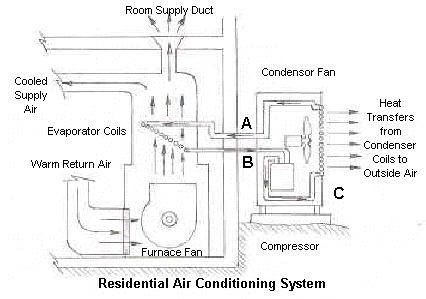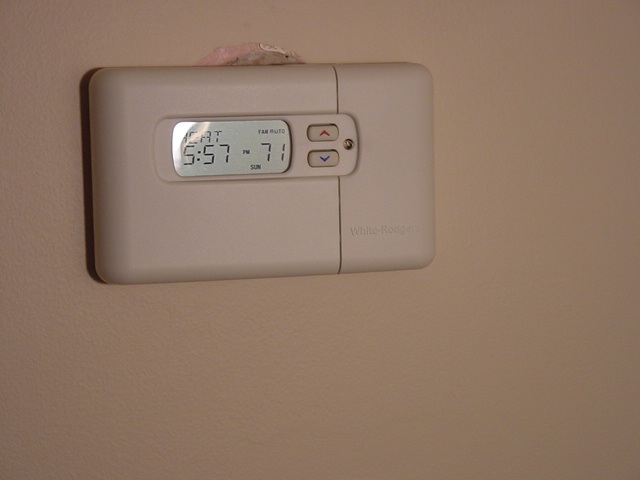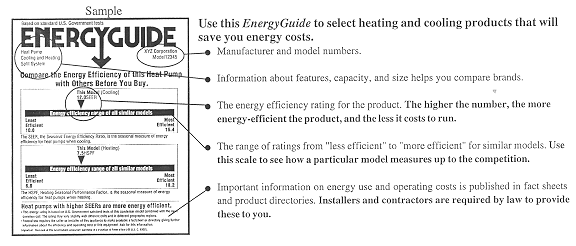|
|
About Cooling Just as homes need to be heated in the winter months, an increasing number of homeowners opt to cool their abodes during the summer months. Over the last twenty years, the number of households that use air condition has almost doubled. With that growth has come a tremendous increase in demand for electricity, a demand that peaks for all households simultaneously on the hottest summer days. For regions with high humidity during the summer months (which covers most of the US), refrigeration is the cooling technology of choice. Refrigeration involves the use of a gas (refrigerant) to transfer heat from one environment to another. The diagram below illustrates the mechanics of this cycle.
As pictured above, an air conditioning system consists of a refrigerant fluid running a copper tube circuit that contains a compressor to pressurize the refrigerant, two sets of coils to exchange heat with air, and a control valve to regulate the pressure drop (not shown). Two fans, each blowing air across the coils, complete the system. Inside the refrigeration circuit, changes to the pressure, temperature, and state of the refrigerant enable the extraction of heat from a home. At point A in the above diagram, the refrigerant is a high pressure, low temperature liquid. As it passes through the control valve (not shown) and the Evaporator Coils, it absorbs the heat of the air being blown over the coils by the furnace fan. The air cools as heat is drawn out of it as it passes through the coils to its way to the various rooms of the house. Once through the coils, a point B, the refrigerant is a low pressure, higher temperature vapor. In the compressor, the refrigerant is compressed, yielding a high pressure, high temperature vapor (point C). As the refrigerant vapor runs through the condensor coils, the outside air draws heat from the refrigerant, causing it to condense to a high pressure, low temperature liquid at point A. From this point the cycle repeats itself. The A/C refrigeration cycle is in motion whenever the fans and the compressor are turning. The thermostat, which is located in the living area of the house, sends on and off signals to the system depending on the temperature in the room and its target or "set" temperature. Whenever the room temperature rises above the set temperature, the thermostat turns on the air conditioning. When the room temperature reaches the set point, it turns the system off. Wall-Mounted Thermostat The unit of capacity for refrigeration systems is tons. One ton equals 12,000 BTU/hour of extracted heat. BTU stands for British Thermal Unit, which the amount of energy it takes to increase one pound of water by one degree Fahrenheit. Most central residential units range from 2-5 tons. Room air conditioners are rated directly as BTU's per hour. Today's market offerings range from 5,000 - 18,000 BTU/hour. Unlike heating systems, which use a variety of fuels, all air conditioning systems are powered by electricity. Since most buildings today have air conditioning, and its usage is driven by the difference between indoor and outdoor temperature, utilities' power demand always peaks on the hottest summer days. For many homeowners, electricity consumed at these peak times is more expensive than electricity consumed during off-peak hours. Consequently, raising the efficiency of air conditioning can produce a sooner than expected payback. For central air conditioning, efficiency is measured as SEER (Seasonal Energy-Efficiency Rating). The higher the rating the higher the efficiency. The ratings are linear, i.e. a rating of 12 uses half the energy as a rating of 6 for the same tonnage. As of October 2000, the minimum SEER rating allowed for new units sold is 9.8. Currently, the highest performing units on the market have a rating of 18. Room air conditioner efficiency is rated in EER (Energy-Efficiency Rating) which is similar to SEER. The US Federal Government requires that all room air conditioners sold through retailers have a bright yellow EnergyGuide label, as shown below. It displays the EER rating for the unit, which can be used by the shopper as basis of comparison between competing units. For otherwise comparable models, the one with the higher EER will use less electricity.
Source: US DOE The heart of a refrigeration system is its compressor. Improvements in compressor technology over the past two decades have resulted in substantial improvements in air conditioning efficiency. Compressors come in two basic types: reciprocating and rotary. Reciprocating compressors have pistons that move back and forth like a car's engine. Rotaries are similar to jet engines - they compress air as they spin. The keys to minimizing the energy usage of an air conditioning system are to - Minimize the amount of heat generated inside the house - Minimize the amount of heat flow into the house - Create virtual cooling inside the house via air circulation - Minimize the heat load outside of the house - Optimize the distribution of cooled air around the house - Keep the system's equipment in peak operating condition Minimizing heat generation In a typical residence, heat is unintentionally generated from several sources: Lighting Lighting, especially the incandescent kind, throws off an abundance of heat. (In fact, 80% of the energy consumed by a light bulb is waste heat) During the cooling season, use of electric lights should be minimized. Clothes drying As the dryer pushes hot damp air outside, it draws in conditioned room air. Consequently, unconditioned outside air will be drawn into the house to equalize the air pressure. In addition, as the unit is in operation, the dryer's cabinet heats up, which creates convection currents in the room. Dishwashing Heat from the hot water used in the washing process conducts through and convects off of the dishwasher's surfaces. Cooking Ranges and ovens employ heating elements to cook food. As with dryers and dishwashers, conduction and convection transfers heat from the appliance to the surrounding indoor air. Some ranges use a hood to draw away the warm, humid, and grease-laden air out of the kitchen. As with the dryers, this air expelled to the outside is eventually replaced with unconditioned outside air. Other Consumer electronics, including TV's, stereos, VCR's, and computers are all generators of heat. If plugged into an outlet, their power supplies continually dissipate heat, even when turned "off". Lighting, as well as appliances for clothes drying, dishwashing, and cooking, are all considered essential elements of modern living. To minimize their impact on the cooling load, they should be used at times of the day when the heat load on the house is the lowest, typically in the evening or very early morning. For homeowners on a "demand" schedule, a secondary benefit is the lower off-hour cost of electricity to run these appliances. In the summer months, cooking of food can be done outdoors with a gas grill. In addition to keeping the kitchen cooler, cooking outdoors with gas may be cheaper than using the electric range in your kitchen. [table - electricity vs. gas cost] Consumer electronics are as bad at generating heat and as they are at wasting electricity. When the TV or stereo or PC is "off" its power supply dissipates electricity as heat as long as it is plugged into a wall outlet. [table of typical drainage currents] Besides remembering to turn off all devices when they are not necessary, they should also be unplugged from the wall socket. If you have a home entertainment center or home office, power can easily be disconnected through the use of a switched power strip. When the area is not in use, which is typically more than 12 hours per day, the power strip should be turned off. Its switch physically opens the circuit, making current flow, and power consumption, impossible. Typical power consumed in the on and off modes in a 24 hour period is summarized below: [table] When purchasing new electronics, always look for the Energy Star label. This certification signifies that the product consumes at least 20% less energy than the maximum allowed by the US Department of Energy. This label is becoming more common in the marketplace as consumers seek goods that are greener and cheaper to operate. [link to Energy Star] Minimize Heat Flow Minimizing heat flow into the house is best accomplished by minimizing heat buildup in the attic and cost-effective insulation. See the Insulation section for further details. Virtual Cooling When you are standing in the hot summer sun and no wind is present, you quickly become uncomfortable. Not enough temperature differential exists between your body and the outside air for the waste heat from your body to transfer effectively. Your body reacts to this situation through perspiration, its own means of cooling itself. If you are standing in the hot sun, but a breeze is present, the heat feels more bearable. As the wind passes over you skin, your perspiration evaporates, which makes you feel cooler. Actually, a gentle airflow can lower the sensed or "virtual" temperature by 6F. In your home, virtual cooling can be achieved through the use of whole house fans and ceiling fans. The whole house fan draws air through open windows in the house and forces it out through the attic. It creates two benefits - (1) the gentle breeze induced throughout the house lowers the virtual temperature and (2) hot air driven out of the attic reduces the amount of heat conduction into the living space below. For outside temperatures up to 83F, a whole house fan can be a reasonable substitute for air conditioning. Using one will enable you to delay usage of your air conditioner at the start of the hot season and to turn it off earlier towards the end of the season. [Diagram of fan action] When the outside air temperature rises above 83F, only air conditioning can maintain a pleasant indoor temperature. However, by using ceiling fans in occupied rooms, you can raise the set temperature on the cooling thermostat a few degrees higher and still maintain comfort. Air conditioning energy savings will be realized with even slightly higher thermostat settings Minimize the Heat Load Outside Tall trees can block the sun's rays from hitting the roof and sides of a house. With proper positioning the cooling load could be reduced as much as 40%. Ideally, in a heating dominated climate, tall evergreen trees flank the north and western sides of a house, while deciduous trees shade the east side . In the wintertime, evergreens oriented on the northern and western sides of the house block the prevailing winter winds, which accelerate heat loss from the exterior walls. The low-in-the-sky sun would be able to radiate on the east and south sides of the house, helping to heat the home in the winter. In the summer, the east side deciduous trees would block the sun's morning rays that would add to the home's cooling load. Because the sun is high overhead during the summer months, it will not shine directly on the south side of the house. Appropriately sized roof overhangs can block any direct sunlight on the south face during the entire cooling season. In cooling dominated climates, i.e. the sunbelt states, it may be beneficial to add deciduous or evergreen trees to the southern side of the house. In the fall and spring months, with the sun descending or ascending in the southern sky, the heat load induced by the sun on the south face of the house may add more to the air conditioning bill than it saves on the heating bill. Blocking the path of the sun's rays to the outside unit of an air conditioner, will allow the air conditioner to operate more efficiently. Locating the unit of the north side of the house helps. Planting trees to the east and west of the unit will provide shade for all but a few hours per day. Care must be taken to not block the unit's air flow out of the top. Optimizing Cooled Air Distribution Optimizing the distribution of cooled air involves the location of ductwork and use of vents. Every room should have a supply air duct and a return air duct. If a room is part of the desired conditioned space, both ducts should be open. Otherwise, the supply duct should be partly shut in the winter and full closed in the summer. If the supply duct is completely closed in the winter, the temperature may drop to a level that would cause pipe freezing. Every duct should be unobstructed to ensure full air flow. If cooling ductwork is routed through unconditioned space, it must be insulated to minimize heat losses. Air Conditioning Maintenance A checklist of servicing items for air conditioning items is shown below: - Check refrigerant level - Clean and flush coils, drain pan, and drainage system - Vacuum the inside of the blower compartment - Check drive belt, if any - Lubricate, if bearings are not permanent seal design - Inspect wiring connections and electrical contacts Next: Energy Savings Opportunities - No Cost Copyright © 2003 HEM Technologies, LLC. All rights reserved. |
| ||||||||||
Energy Savings Opportunities


